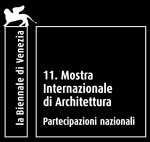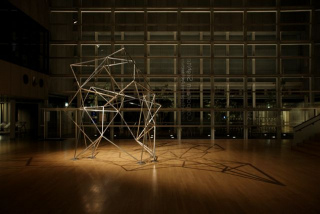On the Corpora Structure – FAQ 1
Posted by PeterFuchs on June 8th, 2008, filed in faq
In the future series of FAQ-s, we are highlighting different aspects of the Corpora project. In this session, Ákos Maróy, Software artist, member of the doubleNegatives group and Beata Oborny biologist having a discussion on the basic nature of the Corpora creature.
BO: What are the basic elements of the Corpora creature? One dimensional rods? Or some sort of 3D structure, like a cube which could be bent for this purpose?
ÁM:The basic elements are simple nodes, “cells”, which are linked together. The links are defined by relative distance – those which are close enough to each other, are becomes linked.
BO: How to address this virtual being? For example, when I would say “X is growing”? X=Corpora?
ÁM: We usually refer it as Corpora Structure.
BO: You are using the term “evolution” in a different way than we, the biologists do. There is nothing bad with this – physicists are using the term also in a different context, by meaning simply “change” with this term. Yet, if we are approaching it from a biologist perspective and looking for an analogy in the field of biology, we have to conclude that what is happening to this creature, is could not be described with the word evolution, but ontogenesis, escpecailly the ontogenesis of a psychical creature.
ÁM: Yes, you are right, this process is much more an ontogenesis, then an evolution by biologist’s terms. But we are using the English term “evolve” for this process, which means singular growth, evolution.
BO: You are also using the term “Cellular Automaton” in a different way than originally intended – or at least, this is how I have seen the word used in your texts: the cellular automaton is discrete in space and time, and is made of identical, regular cells; and the cells might have a limited number of status (finite state machine).
Corpora has “cells” and is an “automaton” in the same time – but for me, it is all, but a Cellular Automaton – at least not in the wide sense of this term.
ÁM: We are using the term of Cellular Automaton in the sense, that Cellular Automatons are systems mode of a large number of cells, and all cells are making local decisions, based on the local set of information.
So, what makes Corpora different to the traditional model of Cellular Automaton are:
- the space structure is not discrete
- there are non-deterministic elements in the rules
- The possible thresholds of statuses which the nodes (cells) might have are limited, even despite the threshold is quite large.
That’s why I would not say Corpora is much different form a regular Cellular Automaton.
OB: If I get this right, all nodes in this structure is in fact considered to be a sensor, therefore “perceives” its surroundings, and the status of adjacent nodes. How does these “virtual sensors” relate to the real ones, which are set up in the actual field, and taking measurements on temperature, wind-force, etc?
MÁ: In Yamaguchi we set up the system like this; for each nodes to use the nearest “real” sensors data. (As we know the location of the node in the space, we can relate to the closest real, psychical sensor, therefore we could decide which one is the closest.) Now, here in Venice we are planning to interpolate the information we get form the sensors, therefore we could project a much detailed image to every space-node, based on the measurements.
BO: Does the algorithm calculates if what the virtual sensors might perceive at the a certain point of the space, based on the data which comes from the real sensors? Is this going to be their own input?
ÁM: See as above. This year, in Venice, we would like to do it like this, if we can manage.
BO: It is hard for me to understand, why you call the pitches in a spatial structure “something which is pitch/point-like” a “cell”.
ÁM: We call them “nodes” actually.
BO: I don’t think it is a good metaphor then. In a biological structured creature, the spatial polygons creates by these points could be considered as “cells”. Even by the terms of the model terminology, it is hardly fits the description, since in the “Cellular Automaton” the cells are not point-like, and join each other by their side (surface), and not hovering far away from each other.
ÁM: Yes, we might only call these cells by the definition of “Cellular Automaton” (that’s how we call them actually). The spatial system is little different, not grid-like, but still has a distinctive, univocal relation amongst the adjacent nodes.
BO: The only way I can imagine is, if you execute a 3D tessellation around each and every point, therefore creating a “cell” from the ‘tessellation polygon’ defined by these points. But in this case, the current definitions for adjecent nodes are not valid any more. So, what makes a point to be a “cell”?
ÁM: The spatial model is different, but Corpora is still a Cellular Automaton in the wide sense of the term. As I perceive, you are limiting the definition of Cellular Automaton into a cubic like form. Therefore, this one is something different.
BO: What effects implement barriers (limits) during this evolving process? I assume it is not possible to grow any way possible. For example, is gravity has an effect? Or any mechanical limits?
ÁM: We defined a certain, limited space, from which for the node it is impossible to expand further. It is possible for nodes to “overage”, after a certain amount of time, the node will not produce any offspring. Some parameters are defined by the data we collected by the surrounding environment, for example: the density of the nodes, (how many neighbors a node might have), or the “endeavor factor” – how high the entire structure might grow.
BO: Does chance plays any role in this process? Or the set of rules you defined are determining the structure, and it is only the outside environment, which implements an element of randomness and abrupt into the evolving process?
ÁM: Yes, there is an element of randomness in the algorithm. New nodes are created by the processing of data we get form the sensors, later modified by the age of the node, and then some elements of chance.
BO: One of your text, on the website states: “Every sensor is linked only with adjacent it.” How does their collected data implemented in the overall process (evolutionary step)? They remain in a local level, or effect the whole structure?
Yes, there is a analogy between the three dimensional model and the real space. The particular nodes are corresponding to the environmental effects around them. If they are located in a warm environment, or a dominantly sunny area, then they will respond accordingly, and if others are located in a cold area for example, those will respond likewise. Therefore, yes, we might say, that basically all decision are made locally in this structure.
BO: Is there any global control (supervisor) over the system? To put the question in a different way: does the right hand know what the left is doing?
Nope :)
BO: It might be convenient to think about Lindenmayer in the case of Corpora.
ÁM: The L-systemsare automatons which making parallel rewritings in the words (in one step more then one rules might be implemented, not just one, which is the case with a normal automaton.) But this could be a Cellular Automaton with parallel rewriting, if we consider it as a formal language automaton.









Leave a Reply
You must be logged in to post a comment.